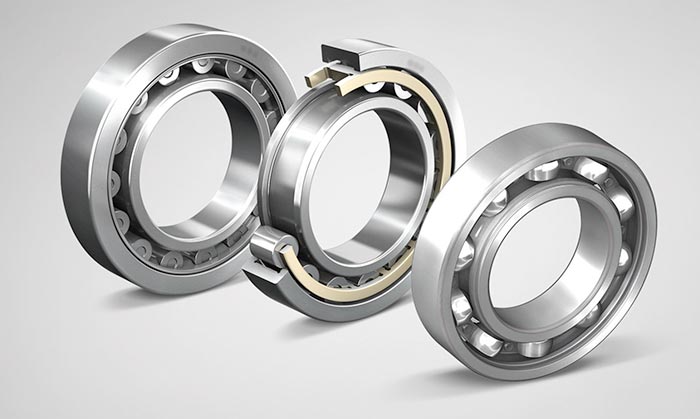What viscosity oil should be used with rolling element bearings?
 Image 1. Rolling element bearings (Image courtesy of Hydraulic Institute)
Image 1. Rolling element bearings (Image courtesy of Hydraulic Institute)The viscosity and type of lubricant used will depend on the bearing design and service. Rolling element bearings (Image 1) in process pumps are lubricated by grease, mineral oil or synthetic oil. When selecting a lubricant, it is important to consider that the primary purpose of oil, or the oil constituent of grease, is to separate the rolling elements and raceway contact surfaces, lubricate sliding surfaces within the bearings and provide corrosion protection and cooling.
Viscosity is an important property of a lubricant, which supports the function of a lubricant in reducing friction and wear. A protective oil film is required to perform these functions. The three basic oil film conditions are referred to as:
- Full film denotes the presence of enough lubricant to ensure complete separation of the moving surfaces. They are also known as hydrodynamic full film.
- Elastohydrodynamic (EHD) is when a hydrodynamic film is formed by applied pressure or load. They are predominantly found in rolling element bearings.
- Boundary layer is sometimes referred to as thin film lubrication and is usually the result of insufficient lubricant supply. Although lubrication is present, there is not enough to prevent metal-to-metal contact.
Oil or grease base viscosity selection is influenced by load, temperature and speed. If an application involves high speeds, low loads and low temperatures, then a low-viscosity lubricant is adequate. Conversely, if low speeds, high loads and high temperatures are the parameters, then a high-viscosity lubricant should be chosen.
Oil in process pumps is typically an ISO grade 32, 46, 68 or 100. These numbers relate to the kinematic viscosity in centistokes. The oil can be hydrocarbon oil, although synthetic oils are used for specific lubrication applications.
The viscosity of synthetic oil is less sensitive to temperature changes and more widely used when temperature fluctuations exist. If temperature also exceeds 100 C (212 F), a synthetic is recommended because the oxidation rate of mineral oil accelerates at higher temperatures.
Use of the correct viscosity lubricant for the speed, temperature and loads ensures the development of a full oil film between rotating parts. The optimum fluid film is sufficiently thick to allow the rolling elements to function without metal-to-metal contact with minimum friction. The functionality of the lubricant is negatively affected when the incorrect viscosity is used.
When viscosity is too low, it can cause mixed or boundary lubrication with resulting heat generation and component wear. Excessively high viscosity will prevent metal-to-metal contact, but will generate unnecessary heat and loss of power as the rolling elements are forced to plow through the oil film.
When is grease used as a bearing lubricant?
The use of grease is primarily limited to lower-horsepower pumps where the parameters are in size and speed range of rolling element bearings.
Grease is usually lithium, with a normal viscosity of 100 centistokes. This typically has a maximum operating temperature of 121 C (250 F), but it is usually limited to a service temperature of 93 C (200 F). To prevent the loss of grease and minimize the entrance of containments, shielded bearings may be used. Shielded bearings are usually limited to a maximum operating temperature of 52 C (125 F).
Advantages to grease lubrication include being less sensitive to level pump installation and simplified maintenance.
Disadvantages to grease lubrication include:
- limited heat dissipation
- overpressurization during regreasing that can damage bearing shields (to avoid, follow manufacturer procedures to prevent overpressurization)
- higher frictional heat from grease used with sealed bearings that can lead to accelerated oxidation of the grease
For more information on lubrication of rolling element bearings, refer to HI’s free white paper, “Proper Lubrication Methods for Bearings,” at pumps.org


